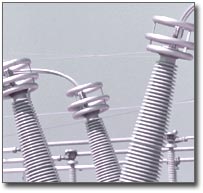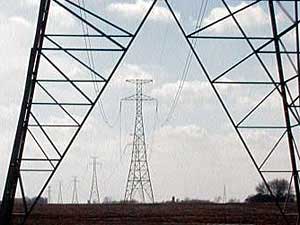JCSP & UMTDI in the news
February 16th, 2009
More transmission – again in the Wall Street Journal.
Hard to tell which of the alphabet soups this article is about, and I’d say both, it’s about the Joint Coordinated System Plan and the Upper Midwest Transmission Development Initiative — UMDTI! But we know it’s all one and the same.
The article doesn’t really specifically name either “group” and it leaves us wondering just who or what is behind it. This is a good thing — yes, it really is as amorphous as it sounds! What disturbs me, of course, is the “It’s for wind,” because we know better!
At least the WSJ noticed the NYISO and ISO-NE’s objections — here it is again, it’s one of those letters I just can’t get enough of:
The UMDTI is insidious, a cheerleading effort to push transmission through. The way the thing is structured, is, as I said in my comments at the February 11, 2009, meeting, is ABSOLUTELY ASS-BACKWARDS. It’s market driven backwards engineering a transmission solution to support nonexistent need.
Upper Midwest Transmission Development Initiative – HOME PAGE
UMTDI Stakeholder Letter 10-28-08
Stakeholder Responses – LINK – look who the stakeholders are – DUH!
Wind on the Wires Comments … sigh…
UMDTI Stakeholder Letter 12-31-08 (Ed Garvey – MISO)
Dec 30 Draft – Cost Allocation Work Group (Marya White – Commerce)
December 30 Draft – Transmission Planning Work Group (Randy Pilo – PSC-WI)
Wind on the Wires cites many studies:
MISO’s Regional Generation Outlet Study (RGOS)
Transmission planning initiatives by” CapX 2020, ATC, Mid-American and others”
Minnesota RES transmission study
MISO’s MTEP-08 and MTEP-09
Joint Coordinated System Planning Stuey
Eastern Wind Integration Transmission Study
None of these studies are linked — and they’re not on the UMTDI site — let’s see how long it takes to find them.
Now for the more difficult ones… one moment please…
NYISO and ISO-NE withdraw from publication of JCSP
February 11th, 2009
I know, that’s a lot of alphabet soup, so let’s do that first.
NYISO is the New York Independent Service Operator, the transmission operator for New York.
ISO-NE is the Independent Service Operator of New England, the transmission operator for New England.
JCSP is the Joint Coordinated system Planning Initiative, conducted by most of the transmission planning entities in the Eastern Interconnect. Each ISO has a JCSP committee, I’m most familiar with the MISO JCSP efforts (AAAAARGH!). I’ve just spent half an hour searching MISO and can’t find the JCSP section, more AAAAAAAARGH… here’s a small piece:
Anyway, as you all know, the “Green Power Express” has been announced, roaring through the Midwest towards the east, a CapX 2020 on steroids.
JCSP has put out a plan, and NYISO and ISO-NE said: PPPPPPPPBBBBBBBFT, I don’t think so, we don’t want to join in publication of this report due to your lack of consideration of efforts we’re doing here, and that you’ve got a lot of coal expansion in your plan. Well, that’s my translation. What do you think?
Here’s their Frbruary 4, 2009 letter to JCSP:
Here it is, do read it yourself and CHEER and SNORT! They have nailed it (EMPHASIS ADDED):
February 4, 2009
TO: THE JOINT COORDINATED SYSTEM PLANNING INITIATIVE
ISO New England and the NYISO are pleased to participate in the Joint Coordinated System Plan (JCSP) initiative that comprises nearly all of the regional planning entities for the Eastern Interconnection. We believe this type of broad, long-term and cooperative approach to power system planning and development is important to inform federal energy policy under the new administration.
The JCSP is a highly valuable activity with respect to the collaboration it promotes among the regional planning organizations within the Eastern Interconnection and the tools it has developed. Even at this early stage of the process, the JCSP has established a framework in which to study the entire Eastern Interconnection in a single multi-regional analysis and developed a common database of information that can be used as a starting point for future studies.
The current JCSP reports on the activities undertaken in 2008, presents analyses of two wind expansion scenarios, that also assume significant baseload coal expansion, and recommends further scenarios for the group to study. ISO New England and NYISO support the JCSP recommendation to pursue additional studies and scenarios and believe these steps are required prior to reaching any broad conclusions on the need for, and scope of, development of large scale transmission. In this regard, the 2008 JCSP report cannot be viewed as a “plan” to be relied upon for decision-making purposes and we believe its publication is premature.
Our primary concern is that the report portrays its analyses to date as a basis for federal policy discussions and decisions regarding major transmission development, as it relates to the integration of renewable resources, notwithstanding the recognized need for additional work. Until additional scenarios that include the development of local resources are analyzed, we do not believe any single transmission plan can be presented as a solution to the integration of additional renewable energy resources in the United States. Conversely, there is significant value in the JCSP studies for policymakers if appropriately presented as technical scenario analysis — coupled with the incorporation of specific planning work already underway in the various regions, including New England and New York, to integrate local renewable resources.
We also have concerns about the inclusion of issues such as cost allocation and “value based planning” considerations in the JCSP report. Since the JCSP is not itself a policy making body, we do not believe these issues should be part of the current scope nor are they appropriate for future JCSP efforts. In fact, we feel that issuing the report as it stands has the potential to constrain future collaboration, and at worst, stimulate counter-productive debate amongst regional planning organizations at it relates to these two policy areas.
In order to ensure that ISO New England’s and NYISO’s specific concerns are fully understood, below is a description of some of the specific activities and initiatives going on in the region and an explanation of how we believe they impact certain JCSP study assumptions and future efforts.
The New England Governors have been working actively for the past two years, not only among the six states in the region, but also in collaboration with the five eastern Canadian provinces of Quebec, Ontario, Newfoundland and Labrador, New Brunswick and Nova Scotia, to consider the integrated development of renewable and non-carbon emitting resources. Numerous proposals to develop renewables within the region (over 4800 MW in the current ISO New England Interconnection queue), including two major off shore wind projects, are being pursued by private entities. The governors and energy policymakers strongly support these developments and view them as economic development opportunities for their states — as well as for advancing air quality and energy security goals. Recently, the governors asked ISO New England for assistance in creating a “blueprint” for developing regional energy resources and overcoming transmission barriers to enhance the energy independence of the region. Furthermore, a number of initiatives in the New England states are promoting energy
efficiency and smart grid technologies. These are in addition to demand resources that are expected to comprise over 8% of the resources procured for our Forward Capacity Market for the year 2011.New York State has put into place an aggressive policy to incent the development of a substantial level of both renewable resources as well as energy efficiency. In his recent State-of-the-State message Governor Paterson announced a further expansion of the State’s efforts to achieve a “45×15” goal: i.e. a 30% level of renewable resources and a 15% reduction in the forecasted energy usage in the State by the year 2015. The energy efficiency program alone, if these goals are achieved, will reduce statewide electric demand by over 5000MW. New York already has nearly 1000MW of wind resources now in operation and the NYISO has another 8000MW in its interconnection queue, including off-shore projects totaling over 1200MW. The NYISO is working with regulators and stakeholders in New York to analyze the local transmission reinforcements that may be required to fully integrate such substantial local wind resources into the wholesale electric markets for the benefit of all consumers in the State.
With the shared geography and history of energy trading patterns between New York and New England with Eastern Canada, significant consideration is also being given to transmission options that would strengthen our access to new supplies of renewable energy—both hydro and wind—now being developed north of our states in Canada. Given these activities, it is reasonable to assume that these resources being developed in the Northeast may be deliverable to customers in our region sooner and more cost-effectively than Midwest wind resources. Given the renewable development, energy efficiency, and likelihood of new ties to Canada, the need to construct long transmission lines to the Midwest would likely be reduced and in turn overall transmission costs may be lower. We believe New England and New York policymakers and stakeholders should have the opportunity to compare such a scenario with the scenarios assumed in the current JCSP report and urge that they be included in future JCSP planning efforts.
We note that the report also assumes the development of new coal-fired generation in the Midwest without recognition of current and future restrictions on carbon emissions and their associated costs. While there is significant uncertainty about the details and timing of federal regulations for carbon, the Regional Greenhouse Gas Initiative (“RGGI”) is in effect today in New England, New York and other Northeast states and its impacts on generation from coal fired resources remains to be seen. In addition, we believe it is likely that the transmission and wind project capital cost estimates contained in the initial JCSP are understated and suggest that modifications to the estimates and estimating process would help to develop a better understanding of the true costs of the expansion scenarios. Future JCSP efforts should also include the ability of stakeholders in the various regions to consider and comment on the assumptions used for these estimates.
These factors, especially the lack of recognition of important New England and New York-specific circumstances require that ISO New England and NYISO withdraw from the publication of the current JCSP study. Despite our inability to participate in the JCSP 2008 report, we intend to continue to participate and work collaboratively towards the modifications suggested above. In order to advance the positive steps made by the participants and the Department of Energy toward joint planning initiatives, we hope that agreement can be reached on the charter, governance and scope of additional JCSP planning efforts and an improved regional stakeholder review process.
Sincerely,
Gordon van Welie
President & Chief Executive Officer
ISO New England Inc.Stephen G. Whitley President & Chief Executive Officer New York Independent System Operator
WELL SAID!!!
Many thanks to the little birdie who sent this:


